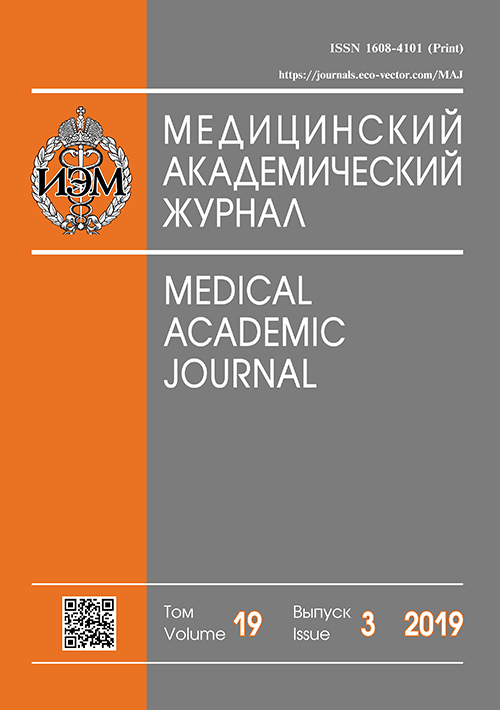Morphofunctional alterations of the hypothalamic neurons activity during sleep-wake cycle regulation disturbances after experimental traumatic brain injury
- Authors: Gavrilov Y.V.1, Derevtsova K.Z.1, Korneva E.A.1,2
-
Affiliations:
- Institute of Experimental Medicine
- Saint Petersburg State University
- Issue: Vol 19, No 3 (2019)
- Pages: 47-56
- Section: Original research
- Published: 26.12.2019
- URL: https://journals.eco-vector.com/MAJ/article/view/18956
- DOI: https://doi.org/10.17816/MAJ19347-56
- ID: 18956
Cite item
Abstract
Relevance. The study of sleep disorders mechanisms after traumatic brain injury is complicated and poorly understood. Traumatic damage to the structures that are responsible for the sleep-wake cycle regulation is a common cause of sleep disorders after traumatic brain injury. The number of hypothalamic neurotransmitter systems, which are involved in the sleep-wake cycle regulation, could change its functional activity after trauma that suggests their key role in the development of disturbances of this process.
The aim of the study was to assess the morphological alterations of the hypothalamus neurons that is involved in the regulation of sleep and wakefulness after traumatic brain injury in an experiment.
Methods. For a combined analysis of posttraumatic disturbances of the sleep-wake cycle and morphofunctional changes in the neurotransmitter systems which are involved in the regulation of the sleep-wake cycle, we used a polysomnography in rats during a month and then an immunohistochemical method for estimating the quantify the orexin A, melanin-concentrating hormone, histamine and tyrosine hydroxylase.
Results. The number of histamine-containing cells in the tuberomammillary nuclei of the hypothalamus is obviously decreased after traumatic brain injury in animals. This alteration of the degree of immunoreactivity of histamine-containing cells after traumatic brain injury correlated with sleep duration changes in animals. The number of noradrenergic and orexinergic neurons was compare with control animal group.
Conclusion. These results suggest that a change in the functional activity of histamine-containing neurons after traumatic brain injury may be the cause of post-traumatic sleep and wakefulness disorders. Our results may lead to a creating of a new approach for a therapy for posttraumatic sleep-wake disturbances.
Full Text
About the authors
Yuri V. Gavrilov
Institute of Experimental Medicine
Email: yury-doctor@mail.ru
ORCID iD: 0000-0003-1409-7686
SPIN-code: 7358-2649
MD, Senior Researcher, Department of General Pathology and Pathological Physiology
Russian Federation, Saint PetersburgKristina Z. Derevtsova
Institute of Experimental Medicine
Author for correspondence.
Email: derevtcova19@ya.ru
ORCID iD: 0000-0001-9855-4519
SPIN-code: 5397-7357
PhD, Senior Researcher, Department of General Pathology and Pathological Physiology
Russian Federation, Saint PetersburgElena A. Korneva
Institute of Experimental Medicine; Saint Petersburg State University
Email: korneva_helen@mail.ru
ORCID iD: 0000-0002-4999-5913
SPIN-code: 8777-2879
Doctor of Medical Science, Academician of the Russian Academy of Medical Sciences, Chief Senior Researcher of the Department of General Pathology and Pathological Physiology; Professor of the Pathophysiology Department
Russian Federation, Saint PetersburgReferences
- Viola-Saltzman M, Watson NF. Traumatic brain injury and sleep disorders. Neurol Clin. 2012;30(4):1299-1312. https://doi.org/10.1016/j.ncl.2012.08.008.
- Rao V, Spiro J, Vaishnavi S, et al. Prevalence and types of sleep disturbances acutely after traumatic brain injury. Brain Inj. 2008;22(5):381-386. https://doi.org/10.1080/ 02699050801935260.
- Rajaratnam SW, Cohen DA, Rogers NL. Melatonin and melatonin analogues. Sleep Med Clin. 2009;4(2):179-193. https://doi.org/10.1016/j.jsmc.2009.02.007.
- Shekleton JA, Parcell DL, Redman JR, et al. Sleep disturbance and melatonin levels following traumatic brain injury. Neurology. 2010;74(21):1732-1738. https://doi.org/10.1212/WNL.0b013e3181e0438b.
- Clinchot DM, Bogner J, Mysiw WJ, et al. Defining sleep disturbance after brain injury. Am J Phys Med Rehabil. 1998;77(4):291-295. https://doi.org/10.1097/00002060-199807000-00006.
- Castriotta RJ, Murthy JN. Sleep disorders in patients with traumatic brain injury: a review. CNS Drugs. 2011;25(3):175-185. https://doi.org/10.2165/11584870-000000000-00000.
- Kaufman Y, Tzischinsky O, Epstein R, et al. Long-term sleep disturbances in adolescents after minor head injury. Pediatr Neurol. 2001;24(2):129-134. https://doi.org/10.1016/s0887-8994(00)00254-x.
- Tobe EH, Schneider JS, Mrozik T, Lidsky TI. Persisting insomnia following traumatic brain injury. J Neuropsychiatry Clin Neurosci. 1999;11(4):504-506. https://doi.org/10.1176/jnp.11.4.504.
- Ayalon L, Borodkin K, Dishon L, et al. Circadian rhythm sleep disorders following mild traumatic brain injury. Neurology. 2007;68(14):1136-1140. https://doi.org/10.1212/01.wnl.0000258672.52836.30.
- Valko PO, Gavrilov YV, Yamamoto M, et al. Damage to histaminergic tuberomammillary neurons and other hypothalamic neurons with traumatic brain injury. Ann Neurol. 2015;77(1):177-182. https://doi.org/10.1002/ana. 24298.
- Harada M, Minami R, Hattori E, et al. Sleep in brain-damaged patients. An all night sleep study of 105 cases. Kumamoto Med J. 1976;29(3):110-127. https://doi.org/10.1093/sleep/11.2.139.
- George B, Landau-Ferey J, Benoit O, et al. [Night sleep disorders during recovery of severe head injuries (author’s transl). (In French)]. Neurochirurgie. 1981;27(1):35-38.
- Willie JT, Lim MM, Bennett RE, et al. Controlled cortical impact traumatic brain injury acutely disrupts wakefulness and extracellular orexin dynamics as determined by intracerebral microdialysis in mice. J Neurotrauma. 2012;29(10):1908-1921. https://doi.org/10.1089/neu.2012.2404.
- Lim MM, Elkind J, Xiong G, et al. Dietary therapy mitigates persistent wake deficits caused by mild traumatic brain injury. Sci Transl Med. 2013;5(215):215ra173. https://doi.org/10.1126/scitranslmed.3007092.
- Büchele F, Morawska MM, Schreglmann SR, et al. Novel rat model of weight drop-induced closed diffuse traumatic brain injury compatible with electrophysiological recordings of vigilance states. J Neurotrauma. 2016;33(13):1171-1180. https://doi.org/10.1089/neu.2015.4001.
- Imbach LL, Valko PO, Li T, et al. Increased sleep need and daytime sleepiness 6 months after traumatic brain injury: a prospective controlled clinical trial. Brain. 2015;138(Pt 3):726-735. https://doi.org/10.1093/brain/awu391.
- Гаврилов Ю.В., Деревцова К.З., Корнева Е.А. Функциональные изменения цикла «сон – бодрствование» после черепно-мозговой травмы в эксперименте // Патогенез. – 2019. – Т. 17. – № 1. – С. 50–56. [Gavrilov YuV, Derevtsova KZ, Korneva EA. Functional changes in the sleep-wake cycle after experimental traumatic brain injury. Pathogenesis. 2019;17(1):50-56. (In Russ.)]. https://doi.org/10.25557/2310-0435.2019.01.50-56.
Supplementary files







